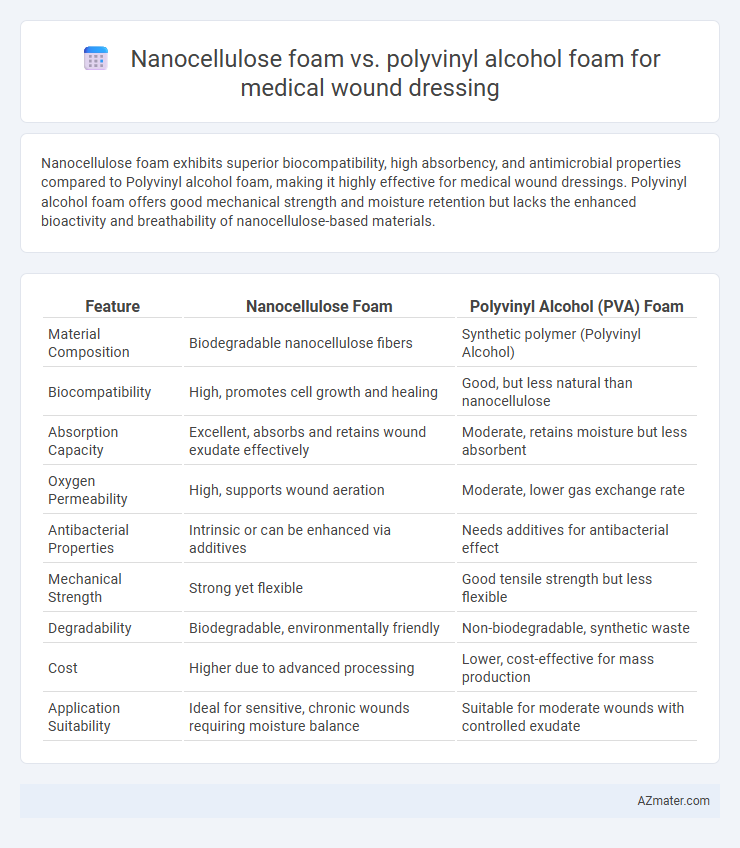Nanocellulose foam exhibits superior biocompatibility, high absorbency, and antimicrobial properties compared to Polyvinyl alcohol foam, making it highly effective for medical wound dressings. Polyvinyl alcohol foam offers good mechanical strength and moisture retention but lacks the enhanced bioactivity and breathability of nanocellulose-based materials.
Table of Comparison
| Feature | Nanocellulose Foam | Polyvinyl Alcohol (PVA) Foam |
|---|---|---|
| Material Composition | Biodegradable nanocellulose fibers | Synthetic polymer (Polyvinyl Alcohol) |
| Biocompatibility | High, promotes cell growth and healing | Good, but less natural than nanocellulose |
| Absorption Capacity | Excellent, absorbs and retains wound exudate effectively | Moderate, retains moisture but less absorbent |
| Oxygen Permeability | High, supports wound aeration | Moderate, lower gas exchange rate |
| Antibacterial Properties | Intrinsic or can be enhanced via additives | Needs additives for antibacterial effect |
| Mechanical Strength | Strong yet flexible | Good tensile strength but less flexible |
| Degradability | Biodegradable, environmentally friendly | Non-biodegradable, synthetic waste |
| Cost | Higher due to advanced processing | Lower, cost-effective for mass production |
| Application Suitability | Ideal for sensitive, chronic wounds requiring moisture balance | Suitable for moderate wounds with controlled exudate |
Overview of Nanocellulose and Polyvinyl Alcohol Foams
Nanocellulose foam, derived from cellulose nanofibers, offers exceptional biocompatibility, high porosity, and excellent moisture retention, making it ideal for medical wound dressings that promote healing and reduce infection risk. Polyvinyl alcohol (PVA) foam is a synthetic polymer characterized by high water absorption, mechanical strength, and flexibility, commonly utilized in wound care for its durability and ability to maintain a moist healing environment. Both materials provide critical benefits in wound management, with nanocellulose emphasizing natural biocompatibility and PVA foam focusing on synthetic robustness and moisture control.
Material Properties Relevant to Wound Dressing
Nanocellulose foam exhibits exceptional biocompatibility, high porosity, and excellent moisture retention, making it ideal for wound healing applications by maintaining a moist environment and promoting cell proliferation. Polyvinyl alcohol (PVA) foam offers strong mechanical stability, flexibility, and good water absorption, facilitating effective exudate management and conformability to wound contours. Both materials provide critical properties for wound dressing, but nanocellulose foam's natural origin and superior breathability enhance tissue regeneration compared to synthetic PVA foam.
Biocompatibility Comparison
Nanocellulose foam exhibits superior biocompatibility compared to polyvinyl alcohol (PVA) foam due to its natural origin, high purity, and non-toxic cellulose fibers that minimize inflammatory responses in wound healing. Studies demonstrate that nanocellulose promotes better cell adhesion, proliferation, and moisture retention, essential for optimal tissue regeneration. In contrast, PVA foam may cause mild cytotoxicity and inflammatory reactions, limiting its effectiveness in sensitive wound environments.
Moisture Management and Absorbency
Nanocellulose foam exhibits superior moisture management and absorbency compared to polyvinyl alcohol (PVA) foam due to its high porosity and hydrophilic nanofiber network that efficiently traps and retains wound exudate. PVA foam, while also hydrophilic, offers moderate absorbency with slower moisture vapor transmission rates, potentially leading to maceration in high-exudate wounds. The enhanced fluid retention and breathable structure of nanocellulose foam promote a balanced moist wound environment, accelerating healing and reducing infection risks.
Mechanical Strength and Flexibility
Nanocellulose foam exhibits superior mechanical strength due to its high tensile modulus and robust hydrogen bonding network, making it highly durable for medical wound dressings. Polyvinyl alcohol (PVA) foam offers greater flexibility and elasticity, allowing it to conform easily to irregular wound surfaces for enhanced patient comfort. The combination of nanocellulose's stiffness and PVA's pliability can be strategically optimized to develop advanced wound dressings with balanced mechanical integrity and flexibility.
Antimicrobial Potential
Nanocellulose foam exhibits superior antimicrobial potential compared to polyvinyl alcohol (PVA) foam in medical wound dressings due to its intrinsic biocompatibility and ability to be functionalized with antimicrobial agents such as silver nanoparticles or chitosan. The high surface area and porous structure of nanocellulose enhance moisture retention and facilitate sustained release of antimicrobial compounds, reducing infection risks effectively. In contrast, PVA foam primarily serves as a physical barrier with limited inherent antimicrobial activity, often requiring additional coatings to achieve comparable antimicrobial efficacy.
Biodegradability and Environmental Impact
Nanocellulose foam exhibits superior biodegradability compared to polyvinyl alcohol (PVA) foam, as it naturally breaks down into non-toxic components through microbial activity, reducing environmental burden. PVA foam, while partially biodegradable, often requires specific conditions or additives to degrade effectively, leading to prolonged persistence in ecosystems. The environmental impact of nanocellulose foam is significantly lower due to its renewable origin and minimal ecological footprint during production and disposal, making it a more sustainable choice for medical wound dressings.
Cost-effectiveness and Scalability
Nanocellulose foam demonstrates superior cost-effectiveness due to its renewable raw materials and lower energy requirements during production compared to polyvinyl alcohol (PVA) foam. Scalability of nanocellulose foam is enhanced by advancements in bacterial cellulose cultivation and chemical extraction methods, enabling large-scale manufacturing with consistent quality. Conversely, PVA foam production involves more complex synthetic processes and higher material costs, limiting its economical scalability for widespread medical wound dressing applications.
Clinical Performance and Case Studies
Nanocellulose foam exhibits superior moisture retention and biocompatibility compared to polyvinyl alcohol (PVA) foam, contributing to enhanced wound healing outcomes in clinical settings. Several case studies demonstrate that nanocellulose dressings reduce infection rates and promote faster epithelialization in chronic wounds, outperforming traditional PVA foam counterparts. Clinical trials highlight nanocellulose foam's effective exudate management and comfort, indicating its potential as a preferred material for advanced wound care applications.
Future Prospects and Innovations in Wound Care
Nanocellulose foam demonstrates superior biocompatibility, high absorbency, and antimicrobial properties, making it a promising material for next-generation medical wound dressings. Polyvinyl alcohol (PVA) foam, known for its excellent mechanical strength and water retention, is being innovated with bioactive agents and controlled drug release systems to enhance healing outcomes. Emerging research focuses on integrating nanocellulose and PVA foams with smart sensing technologies and biodegradable composites, aiming to provide real-time monitoring and environmentally sustainable wound care solutions.

Infographic: Nanocellulose foam vs Polyvinyl alcohol foam for Medical wound dressing
 azmater.com
azmater.com